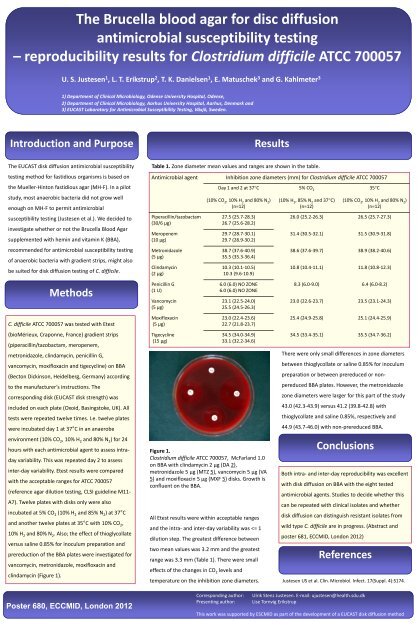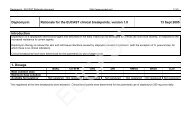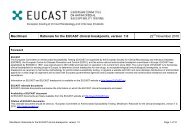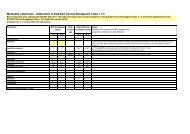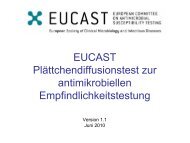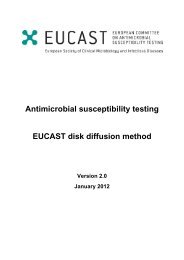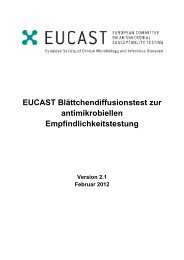6688Susceptibility testing of ten antibiotics against Corynebacterium spp. determined bybroth microdilution, Etest and <strong>EUCAST</strong> disk diffusion methodsC. Salas *1, C. Karlsson 2 , A. Åkerlund3 , C. RodríguezMirones 1 , E. M<strong>at</strong>uschek 2 ,L. Martíneznez-Martínez1,4 , G. Kahlmeter 21Servicio de Microbiología, Hosp. Univ. Marqués de Valdecilla, Santander, Spain. 2 <strong>EUCAST</strong> Labor<strong>at</strong>ory for Antimicrobial Susceptibility Testing, Växjö,Sweden. 3 Department of Clinical and Experimental Medicine, Linköping University, Sweden. 4 Fac. de Medicina, Universidad de Cantabria, Spain.[Revised] AbstractM<strong>at</strong>erial and MethodsObjective: <strong>EUCAST</strong> has not yet defined breakpoints forclinical c<strong>at</strong>egories of clinically relevant antibiotics forCorynebacterium. In this study, the performance of threemethods for susceptibility testing of five Corynebacteriumspecies has been evalu<strong>at</strong>ed.Methods: The activity of penicillin G (PNG), ciprofloxacin(CIP), moxifloxacin (MOX), gentamicin (GEN),vancomycin (VAN), clindamycin (CLI), tetracycline (TET),linezolid (LNZ), rifampin (RIF) and cotrimoxazole (SXT)against 60 Corynebacterium spp. (12 isol<strong>at</strong>es each of thefollowing species: C. stri<strong>at</strong>um, C. amycol<strong>at</strong>um, C. jeikeium,C. urealyticum and C. pseudodiphtheriticum) weredetermined using BMD (broth microdilution with c<strong>at</strong>ionadjustedMueller-Hinton broth with 3% laked horseblood), or on solid medium MH-F (Mueller-Hinton agarwith 5% defibrin<strong>at</strong>ed horse blood and 20 mg β-NAD/L) byEtest and disk diffusion (disk contents as defined by<strong>EUCAST</strong>). BMD was performed in one lab in Spain, Etestin one lab in Sweden and disk diffusion in three labs (onein Spain and two in Sweden). Pl<strong>at</strong>es were incub<strong>at</strong>ed <strong>at</strong> 35ºCin air (microdilution) or 5% CO 2 (agar media) and readafter 16-20 h or, in case of insufficient growth, afteranother 24 h.Results: Microdilution results could be read after 16-20 hincub<strong>at</strong>ion for all species but C. pseudodiphtheriticum. EtestMICs and inhibition zones could be determined <strong>at</strong> 16-20 hfor all 12 C. stri<strong>at</strong>um, but incub<strong>at</strong>ion for 40-44 h wasneeded to a varying degree for other species. Essentialagreement (EA, th<strong>at</strong> in ±1 dilution) between microdilutionand Etest was: PNG (81,7%), CIP (77,9%), MOX (49,1%),GEN (83,0%), VAN (96,6%), CLI (61,0%), TET (59,3%),LNZ (71,1%), RIF (88,3%) and SXT (42,4%). For species,EA were: C. jeikeium (84,2%), C. stri<strong>at</strong>um (77,5%), C.amycol<strong>at</strong>um (73,3%), C. ure<strong>at</strong>lyticum (60,8%) and C.pseudodiphtheriticum (58,5%). Correl<strong>at</strong>ion between BMDMICs and inhibition zones was good, i.e. isol<strong>at</strong>es with highMICs had small inhibition zones and viceversa. Correl<strong>at</strong>ionbetween inhibition zones from three labs was overall good,even when zones had to be read after another 24 h.Conclusions: Growth of Corynebacterium spp. on MH-Fdiffers between species and it is sometimes necessary toincub<strong>at</strong>e pl<strong>at</strong>es for longer than the standard 16-20 h. Thereis a good correl<strong>at</strong>ion between BMD and Etest forvancomycin. More studies on MIC/zone correl<strong>at</strong>ion onspecies-identified Corynebacterium must be performedbefore breakpoints (or ECOFFs) can be established.Background<strong>EUCAST</strong> has not yet established specific criteria forclinical interpret<strong>at</strong>ion of susceptibility testing results forCorynebacterium spp.In this study, we have compared three different methods(broth microdilution, disk-diffusion and gradient-diffusion)to study the in vitro activity of ten antimicrobial agentsagainst five of the more clinically relevant species ofcorynebacteria.We aimed to obtain inform<strong>at</strong>ion aboutperformance of the assays and on the agreement of resultsobtained with every methodology.Bacterial isol<strong>at</strong>es: 60 clinical isol<strong>at</strong>es (12 isol<strong>at</strong>es perspecies), including C. stri<strong>at</strong>um, C. amycol<strong>at</strong>um, C.jeikeium, C. urealyticum and C. pseudodiphtheriticum.Susceptibility testing:Broth-microdilution:In-house prepared microdilution pl<strong>at</strong>es using c<strong>at</strong>ionadjustedMueller-Hinton broth with 3% laked horseblood. The following 10 antibiotics were tested:penicillin G (PNG), ciprofloxacin (CIP), moxifloxacin(MOX), gentamicin (GEN), vancomycin (VAN),clindamycin (CLI), tetracycline (TET), linezolid(LIN), rifampin (RIF) and cotrimoxazole (SXT).Pl<strong>at</strong>es were incub<strong>at</strong>ed <strong>at</strong> 35±2ºC and read after anincub<strong>at</strong>ion in air for 16-20 h.Disk diffusion:<strong>EUCAST</strong> method, using Mueller-Hinton agar with5% of defibrin<strong>at</strong>ed horse blood and 20 mg β-NAD/L(Mueller-Hinton F).ResultsPercentages of strains growing in Mueller-Hinton broth (microdilution) and on Mueller-Hinton F(gradient diffusion) <strong>at</strong> 20/44 h.Essential agreement (%) (in ±1 dilution) between MICs of 10 agents against Corynebacterium spp.determined by gradient diffusion (Etest) with broth microdilution as referencePNG CIP MOX GEN VAN CLIN TET LIN RIF SXT% agreementper speciesC. stri<strong>at</strong>um 83.3 83.3 50.0 91.7 91.7 91.7 66.7 75.0 75.0 66.7 77.5C. amycol<strong>at</strong>um 83.3 100 16.7 100 100 83.3 66.7 83.3 91.7 8.3 73.3C. jeikeium 91.7 100 83.3 91.7 100 83.3 66.7 75.0 100 66.7 84.2C. urealyticum 75.0 75.0 58.3 83.3 100 25.0 25.0 66.7 75.0 25.0 60.8C. pseudodiph. 75.0 27.3 36.4 45.4 90.9 18.2 90.9 54.5 100 45.4 58.5% agreementper antibiotic 81.7 77.9 49.1 83.0 96.6 61.0 59.3 71.1 88.3 42.4The following disks were evalu<strong>at</strong>ed: PNG 1 unit, CIP 5μg, MOX 5 μg, GEN 10 μg, VAN 5 μg, CLI 2 μg, TET30 μg, LIN 10 μg, RIF 5 μg and SXT 1.25-23.75 μg.Gradient diffusion:The <strong>EUCAST</strong> method for disk diffusion was also used,with Etest strips of the same agents considered in thetwo other assays.Agar pl<strong>at</strong>es (both disk diffusion and gradient diffusionmethods) were incub<strong>at</strong>ed in 5% CO 2 for 16-20 h.When growth was insufficient <strong>at</strong> th<strong>at</strong> time, incub<strong>at</strong>ionwas extended for 24 h (total incub<strong>at</strong>ion in these cases:40-44 h.).S. pneumoniae ATCC 49619 and S. aureus ATCC29213 were used as quality control strains.C. stri<strong>at</strong>um ATCC 6940 and C. urealyticum ATCC43042 were also included in the study.ConclusionsNo of readingsNo of readings807060504030201001614121086420Moxifloxacin 5 µg vs. MIC (BMD)Corynebacterium spp, 60 isol<strong>at</strong>es tested <strong>at</strong> three sites10Tetracycline 30 µg vs. MIC (BMD)Corynebacterium spp, 60 isol<strong>at</strong>es tested <strong>at</strong> three sites10121214141616181820202222242426262828Inhibition zone diameter (mm)3032Inhibition zone diameter (mm) Growth on MH-F differs between Corynebacterium species. For some organisms, it is necessary toincub<strong>at</strong>e pl<strong>at</strong>es for longer than the standard 16-20 h, up to 40-44h.There is a good correl<strong>at</strong>ion between BMD/Etest for vancomycin, and to a lesser extent (>80%) forpenicillin, gentamicin and rifampin.Correl<strong>at</strong>ion between MIC/disk difussion was good with small inhibiton zones corresponding tohigh MICs. More studies must be performed before breakpoints (or ECOFFs) can be established.A good correl<strong>at</strong>ion among inhibition zones determined by disk diffussion in the three particip<strong>at</strong>inglabor<strong>at</strong>ories was noted.303432363438364038424044MIC(mg/L)>161684210.50.250.120.060.031684210.50.250.12Examples of combined inhibition zone distributions for Corynebacterium spp.from the three sites with corresponding MIC values as coloured bars.Carlos Salas VeneroE-mail: csalas@humv.es
The Brucella blood agar for disc diffusionantimicrobial susceptibility testing– reproducibility results for Clostridium difficile ATCC 700057U. S. Justesen 1 , L. T. Erikstrup 2 , T. K. Danielsen 1 , E. M<strong>at</strong>uschek 3 and G. Kahlmeter 31) Department of Clinical Microbiology, Odense University Hospital, Odense,2) Department of Clinical Microbiology, Aarhus University Hospital, Aarhus, Denmark and3) <strong>EUCAST</strong> Labor<strong>at</strong>ory for Antimicrobial Susceptibility Testing, Växjö, Sweden.Introduction and PurposeResultsThe <strong>EUCAST</strong> disk diffusion antimicrobial susceptibilitytesting method for fastidious organisms is based onthe Mueller-Hinton fastidious agar (MH-F). In a pilotstudy, most anaerobic bacteria did not grow wellenough on MH-F to permit antimicrobialsusceptibility testing (Justesen et al.). We decided toinvestig<strong>at</strong>e whether or not the Brucella Blood Agarsupplemented with hemin and vitamin K (BBA),recommended for antimicrobial susceptibility testingof anaerobic bacteria with gradient strips, might alsobe suited for disk diffusion testing of C. difficile.Table 1. Zone diameter mean values and ranges are shown in the table.Antimicrobial agent Inhibition zone diameters (mm) for Clostridium difficile ATCC 700057Piperacillin/tazobactam(30/6 μg)Meropenem(10 μg)Metronidazole(5 μg)Clindamycin(2 μg)Day 1 and 2 <strong>at</strong> 37°C(10% CO 2, 10% H 2and 80% N 2)(n=12)27.5 (25.7-28.3)26.7 (25.6-28.2)29.7 (28.7-30.1)29.7 (28.9-30.2)38.7 (37.6-40.9)35.5 (35.3-36.4)10.3 (10.1-10.5)10.3 (9.6-10.9)5% CO 2(10% H 2, 85% N 2and 37°C)(n=12)35°C(10% CO 2, 10% H 2and 80% N 2)(n=12)26.0 (25.2-26.3) 26.5 (25.7-27.3)31.4 (30.5-32.1) 31.5 (30.9-31.8)38.6 (37.6-39.7) 38.9 (38.2-40.6)10.8 (10.4-11.1) 11.8 (10.8-12.3)MethodsPenicillin G(1 U)Vancomycin(5 μg)6.0 (6.0) NO ZONE6.0 (6.0) NO ZONE23.1 (22.5-24.0)25.5 (24.5-26.3)8.3 (6.0-9.0) 6.4 (6.0-8.2)23.0 (22.6-23.7) 23.5 (23.1-24.3)C. difficile ATCC 700057 was tested with Etest(bioMérieux, Craponne, France) gradient strips(piperacillin/tazobactam, meropenem,metronidazole, clindamycin, penicillin G,vancomycin, moxifloxacin and tigecycline) on BBA(Becton Dickinson, Heidelberg, Germany) accordingto the manufacturer’s instructions. Thecorresponding disk (<strong>EUCAST</strong> disk strength) wasincluded on each pl<strong>at</strong>e (Oxoid, Basingstoke, UK). Alltests were repe<strong>at</strong>ed twelve times. I.e. twelve pl<strong>at</strong>eswere incub<strong>at</strong>ed day 1 <strong>at</strong> 37°C in an anaerobeenvironment (10% CO 2 , 10% H 2 and 80% N 2 ) for 24hours with each antimicrobial agent to assess intradayvariability. This was repe<strong>at</strong>ed day 2 to assessinter-day variability. Etest results were comparedwith the acceptable ranges for ATCC 700057(reference agar dilution testing, CLSI guideline M11-A7). Twelve pl<strong>at</strong>es with disks only were alsoincub<strong>at</strong>ed <strong>at</strong> 5% CO 2 (10% H 2 and 85% N 2 ) <strong>at</strong> 37°Cand another twelve pl<strong>at</strong>es <strong>at</strong> 35°C with 10% CO 2 ,10% H 2 and 80% N 2 . Also; the effect of thioglycoll<strong>at</strong>eversus saline 0.85% for inoculum prepar<strong>at</strong>ion andprereduction of the BBA pl<strong>at</strong>es were investig<strong>at</strong>ed forvancomycin, metronidazole, moxifloxacin andclindamycin (Figure 1).Moxifloxacin(5 μg)Tigecycline(15 μg)23.0 (22.4-23.6)22.7 (21.8-23.7)34.5 (34.0-34.9)33.1 (32.2-34.6)Figure 1.Clostridium difficile ATCC 700057, McFarland 1.0on BBA with clindamycin 2 μg (DA 2),metronidazole 5 μg (MTZ 5), vancomycin 5 μg (VA5) and moxifloxacin 5 μg (MXF 5) disks. Growth isconfluent on the BBA.All Etest results were within acceptable rangesand the intra- and inter-day variability was


